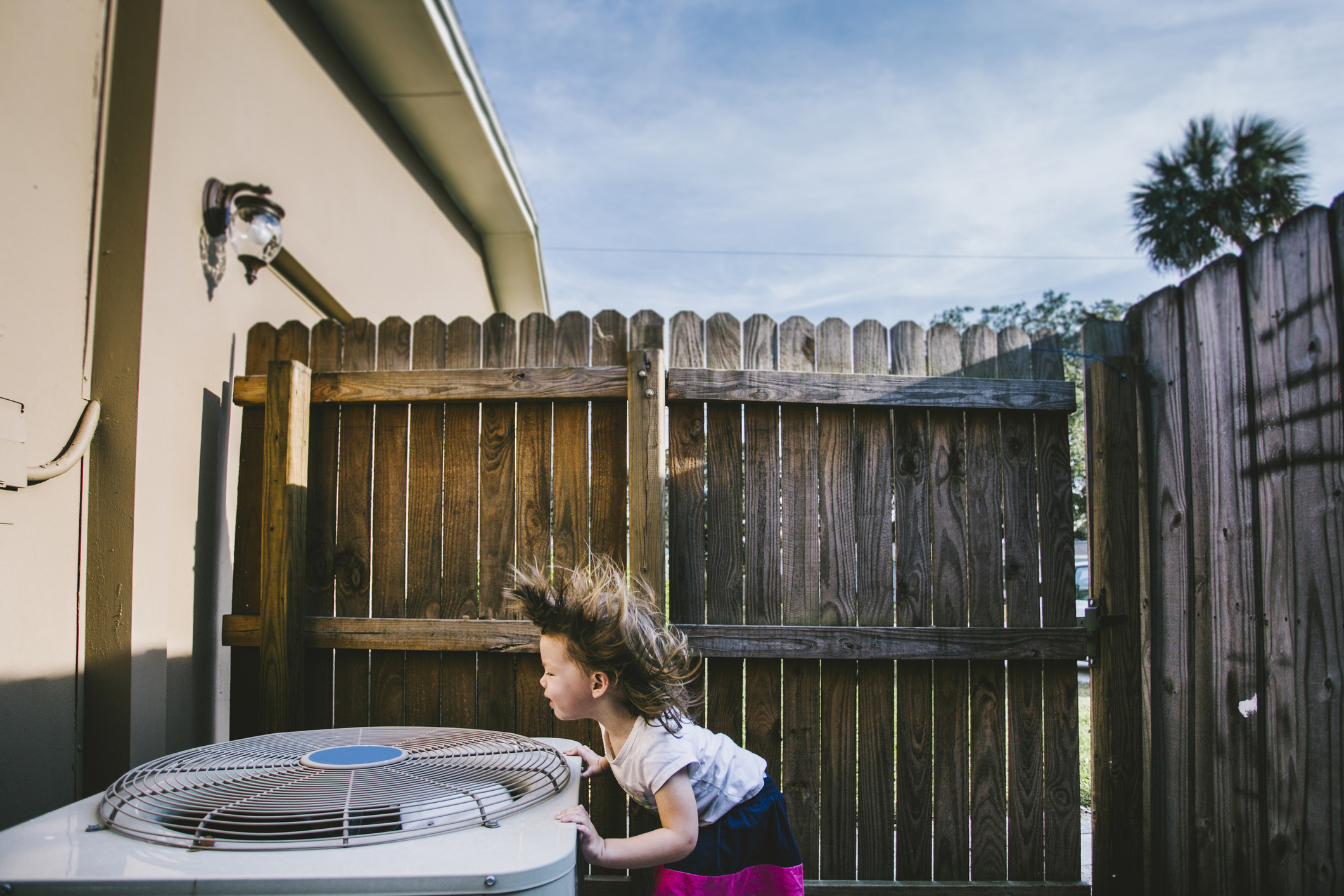Swamp Cooler vs. Air Conditioner: The Best for Dry Heat
Swamp Cooler vs. Air Conditioner: With a scorching summer already underway, which is the better way to cool your home?


Never heard of a swamp cooler? You're not alone. Sometimes called an evaporative cooler, these efficient appliances can help beat the heat in certain climates and may be a better option than air conditioning for some homes. With record-breaking heatwaves and high electric bills, consumers need to find ways to stay cool without paying a fortune.
Here’s what you need to know about swamp coolers vs air conditioners.
Swamp cooler vs air conditioner: mechanical differences
A swamp cooler lowers your home temperature by adding humidity to the air. It works by passing air over a damp pad, letting the moisture from the pad evaporate, which cools the air by 15°- to 40°F before it is directed into the home, as per the DOE. Because of this, swamp coolers are only suitable for low-humidity areas, making them good options for homes in the Western and Southwestern parts of the country.
From just $107.88 $24.99 for Kiplinger Personal Finance
Become a smarter, better informed investor. Subscribe from just $107.88 $24.99, plus get up to 4 Special Issues

Sign up for Kiplinger’s Free Newsletters
Profit and prosper with the best of expert advice on investing, taxes, retirement, personal finance and more - straight to your e-mail.
Profit and prosper with the best of expert advice - straight to your e-mail.
Unlike an air conditioner, a swamp cooler is an open system. This means that you’ll need to have doors or windows at least partially open while running the cooler. Swamp coolers “rely on the flow of air through the building to direct the cool air, and since they always need hot, dry air to evaporate the water, it needs to displace the air already in the house,” according to HowStuffWorks. The warm air has to escape somewhere. That may be a deal-breaker if you have allergies and want to avoid pollen or pollution.
Swamp coolers can be installed on the roof, in a window or on the ground, although most commonly, they’re installed in a down-flow arrangement on a roof, reports the DOE. Small coolers can be installed in a window to heat a specific room in your home, and small, portable evaporative coolers on wheels are now available.
On the other hand, air conditioners cool your home by transferring heat from the interior of your home to a warm outside environment. And it’s a bit more complicated. Here’s how it works, according to the DOE. Basically, an air conditioner contains a liquid refrigerant that evaporates in an interior evaporator coil, “pulling heat out of indoor air and cooling your home.” After which, “the hot refrigerant gas is pumped outdoors into the condenser where it reverts back to a liquid, giving up its heat to the outside air flowing over the condenser's metal tubing and fins.”
Unlike a swamp cooler, installing air conditioning is a more difficult and lengthy process, but can be used in homes in both humid and arid climates. Although they do tend to dry the air.
Upfront costs
The unit's price is a big difference between swamp coolers and air conditioners. How much each cost ultimately depends on the size and type of the unit and how it is installed. However, on average, swamp coolers have lower installation costs, making them cheaper.
The average cost for a swamp cooler installed in a 1,500 sq. ft home is $3,900, while an air conditioner averages $5,000, according to Fixr.
Here’s a price breakdown for swamp coolers, as per Fixr.
- Portable swamp coolers: Range from $100 to $1,500 or more
- Mounted swamp coolers: range from $500 to $1,500
- Window swamp coolers: Range from $300 to $1,000
- Installation costs: Range from $100 (for a simple freestanding unit) to $1,000 (for a mounted unit)
- Overall costs: Range from $100 to $2,500
And here’s a price breakdown for air conditioners, also courtesy of Fixr.
- Portable unit: Range from $200 to $700
- Window unit: Range from $300 to $1,200
- Installation costs: Range from $100 (do it yourself) to $800 (professionally)
- Central units: $1,500 on average, installation costs range from $2,000 to $5,000
- Overall costs: Range from $200 to $6,500
Cost to run and efficiency
Electricity: A swamp cooler uses 60% to 80% less electricity than a standard AC unit, meaning big savings on electricity costs. That efficiency is becoming an ever-more important factor for consumers. According to the U.S. Energy Information Administration (EIA), you can expect to pay more for electricity this summer than last year. The EIA forecasts that residential customers’ monthly electricity bills will average $173 from June to August. Last summer's average was $168.
The EIA also found that monthly costs remain high in dry regions of the country, where swamp coolers might be a good option. The Southwest has the highest average monthly electric bill of $203.
Water: One downside of swamp coolers is their use of water — often a scarce commodity in the arid environments where these appliances are most useful. Estimates of swamp cooler water use vary widely. While air conditioners do not require any water, swamp coolers may use between about 3,000 and 12,500 gallons of water annually, depending on location, size and other factors, according to the New Mexico Office of the State Engineer.
Swamp cooler vs air conditioner: sustainability differences
Overall, swamp coolers are more eco-friendly than air conditioners. They don’t contain any toxic chemicals and typically have lower levels of CO2 and greenhouse gas emissions. If refrigerant from an AC unit leaks, it can have a significant impact on the environment. For example, R-410A, a common refrigerant, has a global warming potential (GWP) of 4,260 over 20 years, according to the Natural Resources Defense Council (NRDC). If a pound of this refrigerant leaks into the atmosphere, it packs 4,260 times the climate wallop as a pound of CO2.
So, if you live in a dry, arid region of the country, not only will using a swamp cooler save you money, but it’ll also pose less of a risk to the environment and reduce your carbon footprint.
Bottom line
Simply put, swamp coolers cool your home by adding humidity to the air, while air conditioners cool your home by pulling heat from inside your home to the outside. And while swamp coolers use significantly less energy and are cheaper than air conditioners, they have a huge drawback. They're most effective in dry climates and aren't suitable for areas with high humidity levels. They may also consume significant amounts of water. However, if you live in a dry climate, such as in the West or Southwest, you can reduce your carbon footprint and help the environment by installing a swamp cooler.
Related Content
Profit and prosper with the best of Kiplinger's advice on investing, taxes, retirement, personal finance and much more. Delivered daily. Enter your email in the box and click Sign Me Up.

Erin pairs personal experience with research and is passionate about sharing personal finance advice with others. Previously, she was a freelancer focusing on the credit card side of finance, but has branched out since then to cover other aspects of personal finance. Erin is well-versed in traditional media with reporting, interviewing and research, as well as using graphic design and video and audio storytelling to share with her readers.
-
 Stocks Struggle Ahead of November Jobs Report: Stock Market Today
Stocks Struggle Ahead of November Jobs Report: Stock Market TodayOracle and Broadcom continued to fall, while market participants looked ahead to Tuesday's jobs report.
-
 7 Dr. Seuss Quotes Retirees Should Live By
7 Dr. Seuss Quotes Retirees Should Live ByYou're off to great places! Why Dr. Seuss is the retirement guru you didn't know you needed.
-
 Fed's Rate Cuts Could Have Impacts You Might Not Anticipate
Fed's Rate Cuts Could Have Impacts You Might Not AnticipateUnderstanding how lower interest rates could impact your wallet can help you determine the right financial moves to make.
-
 I'm a Financial Adviser: The Fed's Rate Cuts Could Have Impacts You Might Not Anticipate
I'm a Financial Adviser: The Fed's Rate Cuts Could Have Impacts You Might Not AnticipateUnderstanding how lower interest rates could impact your wallet can help you determine the right financial moves to make.
-
 My Teen Crashed His Car, and Now Our Insurance Has Tripled. What Now?
My Teen Crashed His Car, and Now Our Insurance Has Tripled. What Now?Dealing with the costly aftermath of a teen car accident is stressful. Here are your options for navigating it.
-
 My First $1 Million: Retired In-House Corporate Lawyer, 74, Midwest
My First $1 Million: Retired In-House Corporate Lawyer, 74, MidwestEver wonder how someone who's made a million dollars or more did it? Kiplinger's My First $1 Million series uncovers the answers.
-
 I'm an Insurance Pro: Going Without Life Insurance Is Like Driving Without a Seat Belt Because You Don't Plan to Crash
I'm an Insurance Pro: Going Without Life Insurance Is Like Driving Without a Seat Belt Because You Don't Plan to CrashLife insurance is that boring-but-crucial thing you really need to get now so that your family doesn't have to launch a GoFundMe when you're gone.
-
 The Top 22 Gifts for Grandkids from Walmart in 2025
The Top 22 Gifts for Grandkids from Walmart in 2025From PlayStation to Labubu, you'll find the hottest gifts of 2025 for your grandkids at Walmart this year. Some of them are up to 78% off.
-
 CD vs. Money Market: Where to Put Your Year-End Bonus Now
CD vs. Money Market: Where to Put Your Year-End Bonus NowFalling interest rates have savers wondering where to park cash. Here's how much $10,000 earns in today's best CDs versus leading money market accounts.
-
 Meet the World's Unluckiest — Not to Mention Entitled — Porch Pirate
Meet the World's Unluckiest — Not to Mention Entitled — Porch PirateThis teen swiped a booby-trapped package that showered him with glitter, and then he hurt his wrist while fleeing. This is why no lawyer will represent him.
-
 Smart Business: How Community Engagement Can Help Fuel Growth
Smart Business: How Community Engagement Can Help Fuel GrowthAs a financial professional, you can strengthen your brand while making a difference in your community. See how these pros turned community spirit into growth.